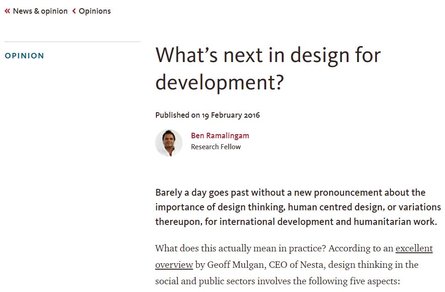
Barely a day goes past without a new pronouncement about the importance of design thinking, human centred design, or variations thereupon, for international development and humanitarian work.
What does this actually mean in practice? According to an excellent overview by Geoff Mulgan, CEO of Nesta, design thinking in the social and public sectors involves the following five aspects:
User focus: designers use ethnographically informed tools to better understand the perspectives those who will be at the receiving end of products and services.
Creative problem solving: design thinkers often come armed with a suite of tools and methods that can help them develop more novel and radical solutions to longstanding problems
Rapid prototyping – the notion of applying ideas quickly, failing and iterating underpins many different aspects of the new wave of development. This can apply to actual physical products (enabled by 3D printing and related technologies) through to fast creation and testing of new systems, services or reforms.
Visualisation – design thinking often uses highly visual ways of framing problems and solutions, which ‘can have a surprising impact in cultures dominated by blocks of prose and the occasional data chart.’ (sound familiar?)
Systems thinking – designers have started to draw on and adopt ideas from complex systems approaches, to identify root causes and asking the right questions to navigate complexity rather than dismissing it.